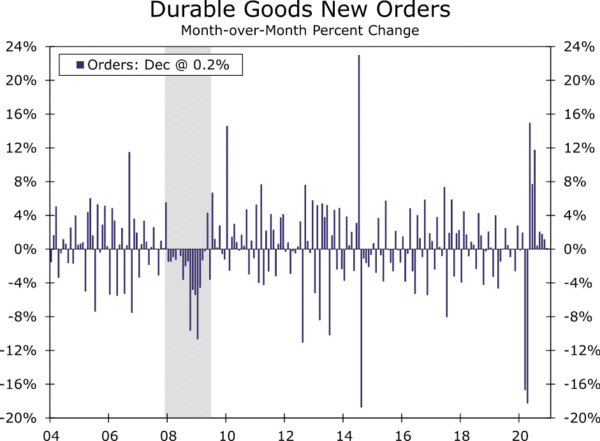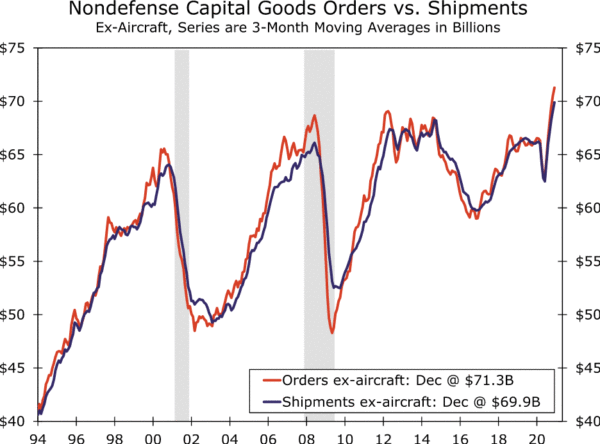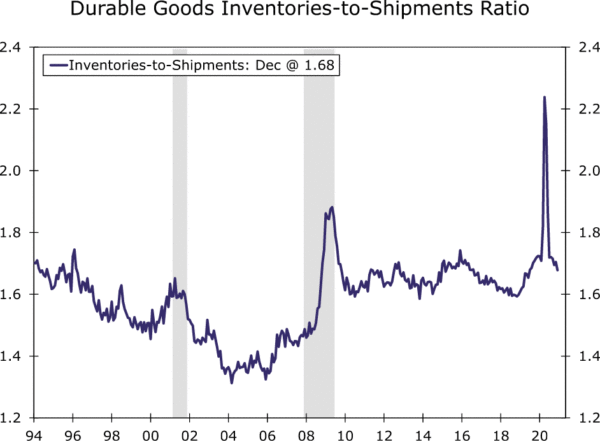Summary
The durable goods report signals that while the post-shutdown surge has faded, underlying strength continues to propel orders and shipment to record levels. The headline miss is mostly attributable to a drop in aircraft orders.
Headline Fade Influenced by Volatile Aircraft Orders
Durable goods orders finished the year with lost momentum as the sequential increase slowed in each of the final three months of the year. December’s monthly gain of just 0.2% was well short of consensus expectations, although the monthly figures for November were revised slightly higher. Despite some soft spots, the details were broadly encouraging.
Civilian aircraft orders dropped 51.8% in December. Historically December is the biggest month for aircraft orders, so the plunge here may say more about the seasonal adjustment process during a generally difficult year for the aviation sector than some specific new deterioration for aircraft makers.
Stripping away the volatile transportation orders, we see orders actually besting expectations slightly, rising 0.7% versus an expected gain of only half a percentage point.
Source: U.S. Department of Commerce and Wells Fargo Securities
Levels at Record Highs
During a time when most analysis is fixated on the shape of the recovery, consider the nearby chart which plots the level of both core capital goods orders and shipments. The recovery is complete; both of these measures are at a higher level now than they were prior to the pandemic. Core capital goods are used as a proxy for underlying business investment spending, and the underlying strength here has been foretold to some extent by the much faster rebound in the ISM manufacturing index compared to its service sector counterpart. The virus and the measures to contain it have exerted a much larger drag on the service sector than it has on manufacturing.
In fact, we have argued that some of the strength in the goods-producing parts of the economy has come at the expense of the service sector. With money not spent on travel, consumers have instead been spending on durable goods. An unwinding of this dynamic is a potential headwind for manufacturing this year, although we expect that to be more than offset by the positive effects from the reopening of the economy once vaccinations return economic activity to something closer to normal.
All Stocked Up?
In the early days of the pandemic, it was all about getting your hands on the stuff you needed. For consumers, that meant shelf-stable grocery items and certain household paper products; for manufacturers, it was about raw materials and input components that oftentimes relied upon far-flung suppliers overseas. Supplier deliveries slowed and some production lines were idled for want of key inputs; this was true in foreign economies as well where manufacturers might have been waiting on U.S. suppliers.
So, one factor that has underpinned the comparatively robust growth in the manufacturing sector has been a restocking of depleted inventories. The initial phase of that replenishment may be starting to run its course. Inventories came down 0.2% in December and the inventory-to-shipments ratio came down to 1.68 in December from a high of more than 2.2 at the height of the crisis.
















